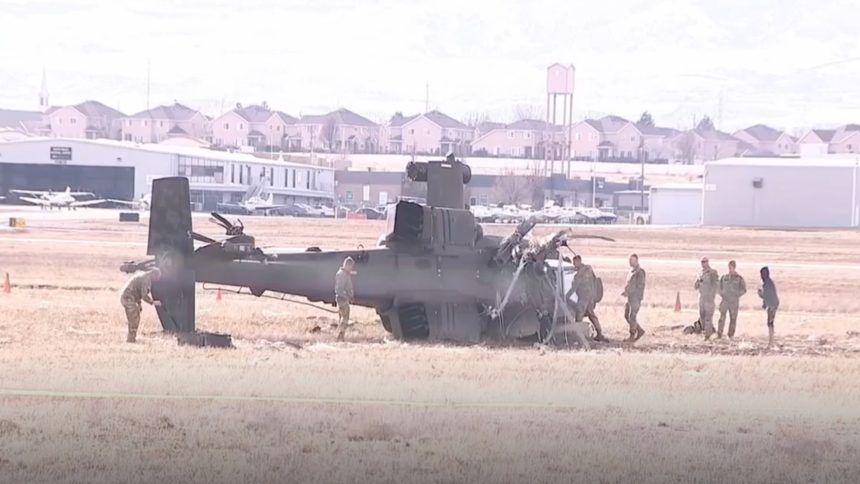An F-35 pilot with only 35 minutes of experience in an Apache simulator was flying the Utah National Guard Apache that crashed earlier this year.
On Feb. 12, 2024, a Utah National Guard AH-64D Apache helicopter crashed during an “orientation flight”. The helicopter was piloted by a colonel in the Air Force Reserve who was not qualified to fly the aircraft. The colonel, an F-35 fighter jet pilot, had only 35 minutes of experience in an Apache simulator before taking control of the real helicopter for a 90-minute flight. According to an investigative report obtained by FOX 13 News, the crash occurred when the colonel, unfamiliar with helicopter controls, attempted to hover and land the Apache at West Jordan airport.
Investigators revealed that during the return to the airport, the colonel struggled to manage the helicopter, necessitating intervention by the accompanying chief warrant officer on three separate occasions. On the fourth attempt, the colonel panicked and reverted to his fixed-wing training, applying downward pressure inappropriate for a rotor-wing aircraft. The Apache rotated and dropped approximately ten feet to the ground before the chief warrant officer could regain control.
The chief warrant officer sustained minor injuries, while the colonel suffered more serious but non-life-threatening injuries that required surgical intervention and rehabilitation.
Fault Found in Leadership and Flight Management
The investigation highlighted not only the colonel’s lack of qualifications but also the chief warrant officer’s overconfidence and inadequate flight control management, which contributed to the crash. Furthermore, the report criticized the Utah National Guard’s chain of command for failing to adequately enforce standard operating procedures, citing similar leadership failures in a 2022 incident involving two Utah National Guard helicopters that crashed at Snowbird Resort.
The investigation’s findings underscore broader implications for military aviation protocols. Investigators recommended that the National Guard Bureau, an office within the Pentagon, reassess the use of orientation flights in Apache units across the nation to prevent future incidents involving unqualified personnel at the controls.
Implications and Response
Orientation flights are routine within military aviation and are typically used to familiarize personnel with different types of aircraft. However, the report suggests a need for stricter adherence to qualification standards to avoid putting unqualified individuals in control of complex and highly technical machinery like the Apache helicopter. The incident has raised questions about the adequacy of current safety measures and leadership oversight within the Utah National Guard.
As of now, the Utah National Guard has not responded to requests for comment regarding the findings of the investigation. The report’s recommendations may prompt changes not only within the Utah National Guard but also across other National Guard units nationwide, highlighting the critical need for strict enforcement of qualification standards in military aviation.
The crash and its subsequent investigation serve as a stark reminder of the importance of proper training and adherence to established procedures in maintaining the safety and integrity of military operations.
Flying the F-35 is probably much simpler
As often explained here at The Aviationist, the F-35 is a 5th generation stealth jet: one of the most complex aircraft ever built but also one of the easiest to fly. In fact, compared to previous generation aircraft, the effort a pilot puts in flying an F-35 is much less than in older aircraft due to its advanced fly-by-wire system, integrated sensors, and highly automated systems. These features significantly reduce the pilot’s workload, allowing them to focus more on mission management rather than basic flight control tasks. The pilot’s effort in a 5th generation aircraft is more on managing the onboard sensors than handling or landing the jet.
This stands in stark contrast to flying a combat helicopter like the AH-64D Apache, which requires continuous manual control inputs to manage the rotor system, maintain stability, and handle complex maneuvers at low altitudes. Helicopters demand constant attention to multiple axes of movement, making them inherently more challenging to pilot compared to the highly automated and stability-focused design of modern jets like the F-35.
1st Attack Reconnaissance Battalion, 211th Aviation Regiment, Utah Army National
The AH-64D Apache helicopters of the Utah National Guard are operated by the 1st Attack Reconnaissance Battalion, 211th Aviation Regiment, based out of West Jordan, Utah, that has performed the Attack and Scout mission for over 40 years and during three recent deployments: Operation Desert Spring (2001-02) in Kuwait, and OEF V (2004-05) and OEF XII (2012-13) in Afghanistan.
The AH-64D Apache Longbow is a twin-engine attack helicopter renowned for its advanced combat capabilities and versatility on the battlefield. It is equipped with a powerful 30mm M230 chain gun, Hellfire missiles, and Hydra 70 rocket pods, allowing it to engage armored vehicles, troops, and other ground targets effectively. The AH-64D features an advanced Longbow radar system, providing target acquisition and tracking even in adverse weather and low-visibility conditions. Its enhanced avionics, night vision systems, and survivability features make it a critical asset for reconnaissance, close air support, and anti-armor missions.
According to the U.S. Army website, the 1st Battalion, 211th Aviation Regiment, known as the 1-211th Attack Reconnaissance Battalion (ARB), plays a crucial role in the Utah National Guard. Its mission is to destroy enemy armored and mechanized forces using aerial firepower, mobility, and shock effect, as well as to conduct aerial reconnaissance and screening operations in support of a Combat Aviation Brigade. The battalion, led by Major Jon Richardson and Command Sergeant Major Shawn Earl, is also prepared to support nationwide aviation operations, emergency situations, and homeland defense missions.
The battalion’s recent training highlights include field exercises, live-fire aerial gunnery, and support for special operations forces. It has participated in high-level training such as the Naval Fighter Weapons School (TOPGUN) and two rotations at the National Training Center in Fort Irwin, California, showcasing its capability to provide effective air support and rapid deployment in both combat and domestic missions.
The 1-211th ARB is structured into several companies, including Headquarters Company and A through E Companies, each contributing to the unit’s overall mission readiness and operational excellence.









